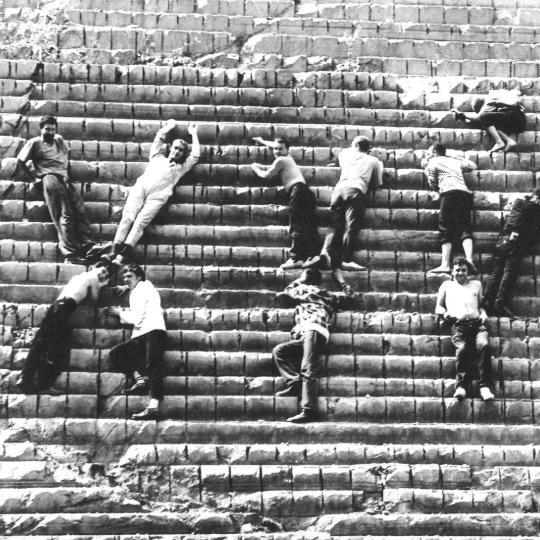THE FOURTH
INTERNATIONAL
DADA FESTIVAL
3.2. – 1.5. 2003 / ZÜRICH, SWITZERLAND
Back in Zurich I found no available unoccupied properties I could squat for an inhabited sculpture. For the first time in my life in Zurich I was
paying rent and continued to sell illegal cheap Portuguese beer from my bed during salon parties in the rented commercial space over “Sexy 2000”
in the Sihlhallenstrasse.
After the demise of the Plattenstrasse squat the group of the former Dada occupiers were homeless again, and some of
them even spent nights in police custody after unsuccessful squatting attempts. It was nearly February again and the next Dada festival weeks were
due. To express our indignation about the reopening of the Cabaret Voltaire as a Swatch Souvenir Shop, we decided to surround the desecrated
birthplace of Dadaism with actions at adjacent locations in the Niederdorf area under the slogan “Sticking feathers up your ass does not make you a
chicken“.

Pastor Leumund discovered a suitable location for our stage program in the sex movie theater Stüssihof. As the base for the festival weeks
we targeted the empty gallery arcade in the Rämistrasse, which was soon to be converted into an art library. After taking over these locations two
weeks before the start of the festival I was able to sign a “user loan” agreement for a period of several months.

The opening event took place in the
Casabar, right next to the Cabaret Voltaire, whose operators supplied us with drinks from their beer cellar during the Cabaret times and to whom
we had a very good rapport. The eight gallery ateliers in prominent locations rapidly mutated into bizarre parallel adventure playgrounds for adults
incorporating individual artists as well as collectives such as Marks Blond or the Hot Lobster Jazz Band. Every day a copy of „Chicken News“ came
out featuring the outpourings of visitors recorded on open-to-all typewriters.

ARTISTS: Ajana Calugar / Andrea Muheim / Anton Beton / Anne Von Gunthen / Andreas Niederhauser / Alexis le bien / Bitnik / Biopop / Boris Von Der Burg / Blitztheater Zürich
Chloe Nicolet di Felix / Christian Anderson / David Thayer / Dimitry Bulnygin / Denis Stoffner / Dogan Firuzbay / David Renggli / Derek al Rämsi / DJ Blade / DJ Patex / Directantrieb / DJ Betty Bossa / Elektra Sturmschnell / Ernst Scholl Trio / Ernst Shoeller / Etrit Hasler / Fehlfunktion / Florian Kalotay / Franziska Koch / Frau Kraushaar / Good by Lenin / Guerillia Girls / Ich jetzt täglich / Ingo Giezendanner / Grrrr / Gabriel Serra / Hollow Man / Habib Afsar / Jenny Fröhlich / Jurczok 1001
Kay-Zee / Ken und Barbie / Kiilo / Kcor / Lucien Samaha / Lucia Schüriger / Loredana Sperini / Malik Sabotage / Marcel Kühne / Mark Divo / Marks Blond
Mauro Arnold / Michael Schmacke / Mickry 3 / Micromops / Mirzlekid / Minimal Turntablists / Max Rheimer / Maria Pamiansky / Margarita Tarnover / Mark Matthes / Monoblock B. / Mo Diener / Moshmosh / Nanu / Nina Strüver / Oskura / Playme / Pascal Häuserman / Rockmaster / Raphael Perret / Räto Jost / Rachel de Rothechild
Rätsel / Sarah Kreuter / Smith and Smart / School of Zuversicht / Seb de la Tor / Svetlana Mazoulevskaja / Smith & Smart / Sista Esta / Tanja Roscic / Triphase und sic
Teresa Pereira / Urs Lehmann / Veronica Ehrensprenger / Wolga Gambit / Zaccheo Zilioli / Zizidää














































